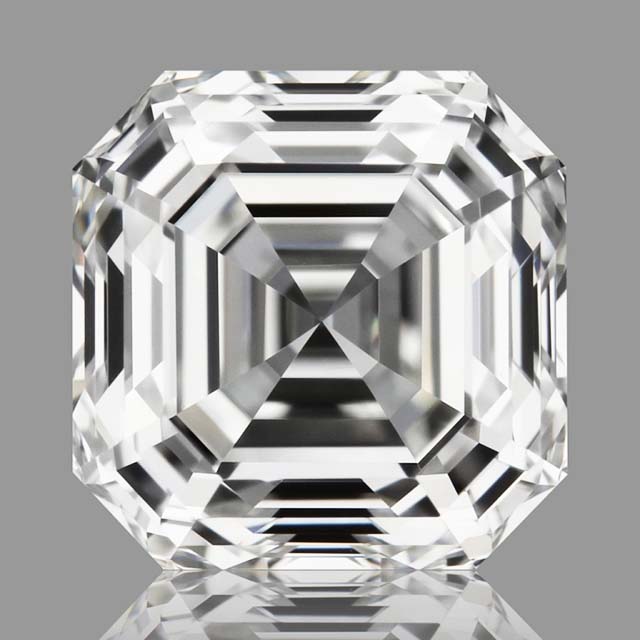The Asscher cut diamond is a variation of the square emerald cut diamond. The configuration of the facet structure produces a hypnotic pattern of concentric squares shown below.
You know that feeling that you get when you stand at the top of a spiral staircase and look down? That is the feeling I get when I stare into the table facet of an Asscher cut diamond. It’s like peering into the depths beyond the looking glass.
Perhaps that is why I’m so fond of these of step-cut diamonds, each one is a visual adventure unto itself. Many people believe the Asscher cut diamond is the predecessor to the modern emerald cut diamond. It first emerged on the scene in the early 1900’s and took the market by storm.
Diamond and Jewelry Coupons & Sales:
* See individual sites for terms and conditions.
Asscher Cut Diamond Shape:
The classic Asscher cut diamond has a slightly octagonal shape that is similar to a stop sign. However the outline is not perfectly octagonal, the shape features large cut corners.
From a top down perspective (face-up) this creates a reflection pattern similar to a a windmill. Unfortunately it is extremely difficult to find an Asscher cut diamond that meets my expectations.
The quest to find the perfect Asscher cut diamond is likely to leave you feeling like Don Quixote. That’s because the vast majority of Asscher cut diamonds are poorly cut despite the GIA Excellent rating.
That’s because the symmetry grade on a lab report refers to "meet point symmetry” not optical precision. Meet point symmetry refers to how well the facet "meet” at the junction points. Optical precision focuses on consistency of facet structure from the perspective of 360 degrees.
Key Components of an Asscher Cut Diamond:

The windmill effect and pattern of concentric squares visible under the table facet are critical components. It goes without saying that the windmill and concentric square patterns should be symmetrical.
Sadly, most of the Asscher cuts that I evaluate lack real symmetry (despite the GIA Excellent grade). Which is why you should insist on clarity photographs or high definition video!
Did you happen to notice that every one of the diamonds pictured above has a slightly different outline? Each one looks dramatically different than the other, which actually is part of the appeal.
However it is this type of variation that makes clarity photographs a critical part of the selection process! Reflector scope photographs are incredibly helpful. This ASET image enables us to judge how evenly light reflects throughout the stone.
Best Proportions for Asscher Cut Diamonds:
The reality is that there is not a set of proportions that guarantees the best light performance for this shape. It is not possible to estimate the light return of an Asscher using proportions due to variations in design.
It's a bit different with a round brilliant because the shape is symmetrical and there is a standard facet structure. That said, there is a range of proportions that I rely upon when searching for this shape:
Classic Proportions for Asscher Cut Diamonds:
In my experience, most people will take this range of proportions for Asscher cut diamonds quite literally. However I chose my words quite carefully, please take note. "In the range of” literally means within the tolerance of that target range.
So an Asscher cut diamond with a total depth of 71% and a table diameter of 66% might be acceptable. That would be in the range of the proportions provided herein. What’s more important to me are the visual properties of the diamond, refer to the key components outlined above.
In a perfect world, I prefer that both the polish and symmetry grades be GIA Excellent or AGS Ideal. However it’s more likely that you’re going to find something that is very good for both categories. There is a small handful of diamond cutters producing Asscher cut diamonds with GIA Excellent polish and symmetry.
The best way to find an Asscher cut diamond is to ask me to conduct a search. Please take advantage of my free Diamond Concierge Service.
Best Clarity and Color for Asscher Cut Diamonds:
Step-cut diamonds feature a large table facet with each outer row of facets stepping down to the next. Each section of facets literally steps down from the next. This shape lacks the variation of facet shapes necessary to break light into smaller pieces of sparkle.
The reality is that there isn't a lot of sparkle being created to distract our eyes from seeing inclusions. For this reason, I recommend a minimum clarity of VS-1 for an Asscher cut diamond.
For the same reasons, I recommend going with a higher color for this diamond shape. With a round brilliant, all that sparkle serves to distract our eyes and make it harder to see diamond color.
But it's pretty easy to see color in step-cut diamonds, so I recommend sticking with the D-color to I-color range. Of course, you might prefer diamonds that are warmer in tone, so feel free to choose whatever color grade you prefer.
History of the Asscher Cut Diamond:
The asscher cut diamond is the brain child of the Asscher Brothers of Holland. They're the same guys who cut the famous Cullinan Diamond, which weighs 3,106 carats.
Can you imagine? That's a diamond that weighs 621.35 grams, which is 1.36984227 pounds in case you're wondering. As you might imagine, the popularity of diamond shapes ebbs and flows with time.
This diamond shape was most popular in the 1920's. Then it roared back on to the scene around 2000 along with many other fancy shape diamonds. Improvements in diamond design and modern cutting techniques deliver higher visual performance.
Asscher Vs. Other Diamond Shapes:
Be sure to read our buying guides for other shapes if you're trying to decide whether the Asscher cut diamond is right for you.
If you'd like help with your search or have any questions, feel free to use our Diamond Concierge Service.


